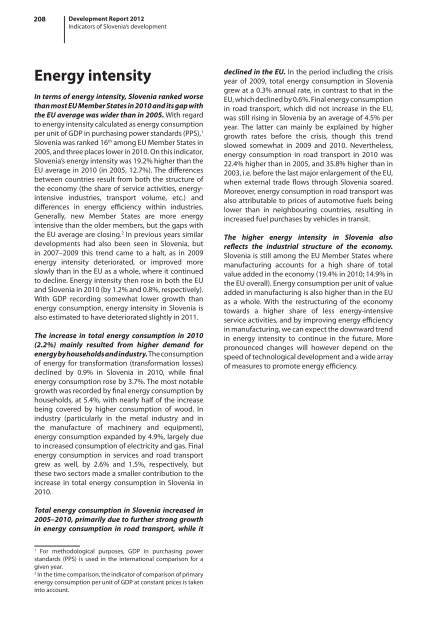development report 2012 - UMAR
development report 2012 - UMAR
development report 2012 - UMAR
Create successful ePaper yourself
Turn your PDF publications into a flip-book with our unique Google optimized e-Paper software.
208 Development Report <strong>2012</strong><br />
Indicators of Slovenia’s <strong>development</strong><br />
Energy intensity<br />
In terms of energy intensity, Slovenia ranked worse<br />
than most EU Member States in 2010 and its gap with<br />
the EU average was wider than in 2005. With regard<br />
to energy intensity calculated as energy consumption<br />
per unit of GDP in purchasing power standards (PPS), 1<br />
Slovenia was ranked 16 th among EU Member States in<br />
2005, and three places lower in 2010. On this indicator,<br />
Slovenia’s energy intensity was 19.2% higher than the<br />
EU average in 2010 (in 2005, 12.7%). The differences<br />
between countries result from both the structure of<br />
the economy (the share of service activities, energyintensive<br />
industries, transport volume, etc.) and<br />
differences in energy efficiency within industries.<br />
Generally, new Member States are more energy<br />
intensive than the older members, but the gaps with<br />
the EU average are closing. 2 In previous years similar<br />
<strong>development</strong>s had also been seen in Slovenia, but<br />
in 2007–2009 this trend came to a halt, as in 2009<br />
energy intensity deteriorated, or improved more<br />
slowly than in the EU as a whole, where it continued<br />
to decline. Energy intensity then rose in both the EU<br />
and Slovenia in 2010 (by 1.2% and 0.8%, respectively).<br />
With GDP recording somewhat lower growth than<br />
energy consumption, energy intensity in Slovenia is<br />
also estimated to have deteriorated slightly in 2011.<br />
The increase in total energy consumption in 2010<br />
(2.2%) mainly resulted from higher demand for<br />
energy by households and industry. The consumption<br />
of energy for transformation (transformation losses)<br />
declined by 0.9% in Slovenia in 2010, while final<br />
energy consumption rose by 3.7%. The most notable<br />
growth was recorded by final energy consumption by<br />
households, at 5.4%, with nearly half of the increase<br />
being covered by higher consumption of wood. In<br />
industry (particularly in the metal industry and in<br />
the manufacture of machinery and equipment),<br />
energy consumption expanded by 4.9%, largely due<br />
to increased consumption of electricity and gas. Final<br />
energy consumption in services and road transport<br />
grew as well, by 2.6% and 1.5%, respectively, but<br />
these two sectors made a smaller contribution to the<br />
increase in total energy consumption in Slovenia in<br />
2010.<br />
declined in the EU. In the period including the crisis<br />
year of 2009, total energy consumption in Slovenia<br />
grew at a 0.3% annual rate, in contrast to that in the<br />
EU, which declined by 0.6%. Final energy consumption<br />
in road transport, which did not increase in the EU,<br />
was still rising in Slovenia by an average of 4.5% per<br />
year. The latter can mainly be explained by higher<br />
growth rates before the crisis, though this trend<br />
slowed somewhat in 2009 and 2010. Nevertheless,<br />
energy consumption in road transport in 2010 was<br />
22.4% higher than in 2005, and 35.8% higher than in<br />
2003, i.e. before the last major enlargement of the EU,<br />
when external trade flows through Slovenia soared.<br />
Moreover, energy consumption in road transport was<br />
also attributable to prices of automotive fuels being<br />
lower than in neighbouring countries, resulting in<br />
increased fuel purchases by vehicles in transit.<br />
The higher energy intensity in Slovenia also<br />
reflects the industrial structure of the economy.<br />
Slovenia is still among the EU Member States where<br />
manufacturing accounts for a high share of total<br />
value added in the economy (19.4% in 2010; 14.9% in<br />
the EU overall). Energy consumption per unit of value<br />
added in manufacturing is also higher than in the EU<br />
as a whole. With the restructuring of the economy<br />
towards a higher share of less energy-intensive<br />
service activities, and by improving energy efficiency<br />
in manufacturing, we can expect the downward trend<br />
in energy intensity to continue in the future. More<br />
pronounced changes will however depend on the<br />
speed of technological <strong>development</strong> and a wide array<br />
of measures to promote energy efficiency.<br />
Total energy consumption in Slovenia increased in<br />
2005–2010, primarily due to further strong growth<br />
in energy consumption in road transport, while it<br />
1<br />
For methodological purposes, GDP in purchasing power<br />
standards (PPS) is used in the international comparison for a<br />
given year.<br />
2<br />
In the time comparison, the indicator of comparison of primary<br />
energy consumption per unit of GDP at constant prices is taken<br />
into account.
















